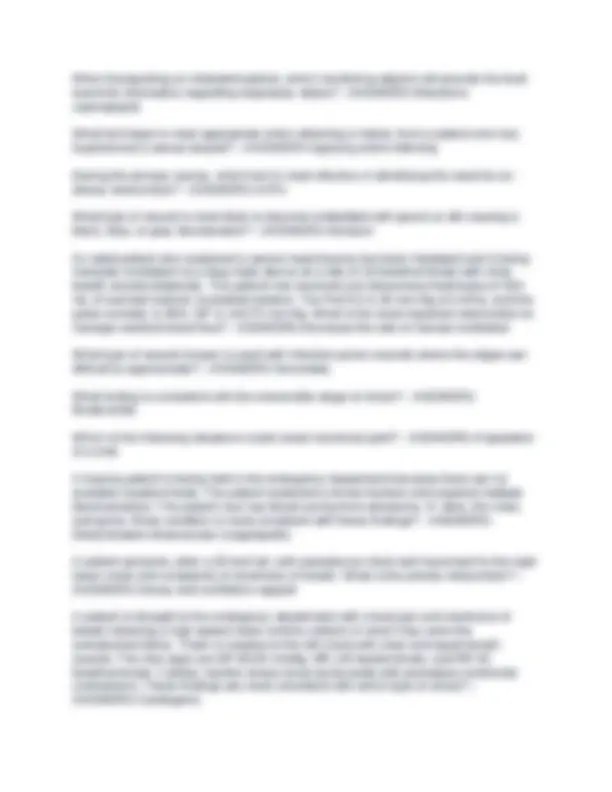





Study with the several resources on Docsity

Earn points by helping other students or get them with a premium plan


Prepare for your exams
Study with the several resources on Docsity

Earn points to download
Earn points by helping other students or get them with a premium plan
Community
Ask the community for help and clear up your study doubts
Discover the best universities in your country according to Docsity users
Free resources
Download our free guides on studying techniques, anxiety management strategies, and thesis advice from Docsity tutors
Which intervention is recommended regarding the use of drug-assisted intubation and rapid sequence intubation? - ANSWERS-Pre-oxygenate to prolong the time to hypoxia Which normal anatomic or physiologic change in an older adult places them at a higher risk for aspiration? - ANSWERS-Relaxed muscles of the oropharynx A patient has been diagnosed with an incomplete spinal cord injury at L1. Which finding would indicate sacral sparing? - ANSWERS-Voluntary anal sphincter tone An adult patient weighing 75 kg sustained partial and full thickness burns to 32% of their body 2 hours prior to arrival. Intravenous fluid resuscitation was calculated to be 400 mL/hour. The urine output over the last hour was 15mL. What intervention should the nurse anticipate? - ANSWERS-Increase isotonic crystalloid infusion rate
Typology: Exams
1 / 6

This page cannot be seen from the preview
Don't miss anything!




Which intervention is recommended regarding the use of drug-assisted intubation and rapid sequence intubation? - ANSWERS-Pre-oxygenate to prolong the time to hypoxia Which normal anatomic or physiologic change in an older adult places them at a higher risk for aspiration? - ANSWERS-Relaxed muscles of the oropharynx A patient has been diagnosed with an incomplete spinal cord injury at L1. Which finding would indicate sacral sparing? - ANSWERS-Voluntary anal sphincter tone An adult patient weighing 75 kg sustained partial and full thickness burns to 32% of their body 2 hours prior to arrival. Intravenous fluid resuscitation was calculated to be 400 mL/hour. The urine output over the last hour was 15mL. What intervention should the nurse anticipate? - ANSWERS-Increase isotonic crystalloid infusion rate A patient is diagnosed with a T12 spinal cord injury following a 20-foot fall. Which finding is consistent with spinal shock? - ANSWERS-Loss of reflexes A patient is brought to the emergency department following a motor vehicle rollover and is complaining of left upper abdominal pain and left shoulder pain. This presentation is most consistent with an injury to which organ? - ANSWERS-Spleen An adult patient is brought to the emergency department following a motor vehicle collision with complaints of neck pain. They have identified as a person in the process of transitioning from male to female. What effect of hormone therapy should be considered when planning care for this patient? - ANSWERS-Testosterone therapy may decrease blood pressure Correct rationale: A person who is in the process of transitioning from male to female will usually be taking female hormones such as estrogen/estradiol to assist with the transition. This can cause a decrease in muscle mass, increased risk of thromboembolism, and possibly increased bone density. These patients would not be taking testosterone. An adult patient presents to the emergency department after sustaining severe facial injuries during an altercation. The patient is awake, confused, and smells heavily of
alcohol. Pulse oximetry is 94% on room air. Immediate intubation should be anticipated based on which clinical indicator? - ANSWERS-Severe facial injuries A patient involved in a high-speed rollover is complaining of increased difficulty breathing. There is a small penetrating wound to the sixth intercostal space in the left lateral chest. Which finding is most consistent with an injury to the diaphragm? - ANSWERS-Bowel sounds heard in the left lower chest A severely injured patient has been intubated and is being mechanically ventilated. The patient has received a balanced resuscitation including multiple blood products. Under which circumstance will it be harder for the hemoglobin to release oxygen to the tissues? - ANSWERS-Decreased body temperature A patient with a chest tube is being transported to the intensive care unit and fluctuation is noted in the water seal chamber during inspiration and expiration. What is the best action for the nurse to take? - ANSWERS-Continue to the intensive care unit An adult was thrown against a concrete wall during a factory explosion and sustained a femur fracture, liver laceration, and a small subdural hematoma. These injuries most likely occurred during what level of blast trauma? - ANSWERS-Tertiary An obese trauma patient requires intubation. Assuming there are no contraindications, which position will provide the best visualization for insertion of the endotracheal tube? - ANSWERS-Ramped A patient who jumped out of a second-floor window landing on their feet is diagnosed with a lumbar spine fracture. What is the most likely concurrent injury to have occurred?
When transporting an intubated patient, which monitoring adjunct will provide the best real-time information regarding respiratory status? - ANSWERS-Waveform capnography What technique is most appropriate when obtaining a history from a patient who has experienced a sexual assault? - ANSWERS-Applying active listening During the primary survey, which tool is most effective in identifying the need for an airway intervention? - ANSWERS-AVPU What type of wound is most likely to become embedded with gravel or dirt causing a black, blue, or grey discoloration? - ANSWERS-Abrasion An adult patient who sustained a severe head trauma has been intubated and is being manually ventilated via a bag-mask device at a rate of 18 breaths/minute with clear breath sounds bilaterally. The patient has received one intravenous fluid bolus of 500 mL of warmed isotonic crystalloid solution. The PaCO2 is 30 mm Hg (4.0 kPa), and the pulse oximetry is 96%. BP is 142/70 mm Hg. What is the most important intervention to manage cerebral blood flow? - ANSWERS-Decrease the rate of manual ventilation What type of wound closure is used with infection-prone wounds where the edges are difficult to approximate? - ANSWERS-Secondary What finding is consistent with the irreversible stage of shock? - ANSWERS- Bradycardia Which of the following situations could cause functional grief? - ANSWERS-Amputation of a limb A trauma patient is being held in the emergency department because there are no available inpatient beds. The patient sustained a femur fracture and required multiple blood products. The patient now has blood oozing from abrasions, IV sites, the nose, and gums. What condition is most consistent with these findings? - ANSWERS- Disseminated intravascular coagulopathy A patient presents, after a 25-foot fall, with paradoxical chest wall movement to the right lower chest and complaints of shortness of breath. What is the priority intervention? - ANSWERS-Airway and ventilation support A patient is brought to the emergency department with chest pain and shortness of breath following a high-speed motor vehicle collision in which they were the unrestrained driver. There is crepitus to the left chest with clear and equal breath sounds. The vital signs are BP 80/40 mmHg, HR 140 beats/minute, and RR 40 breaths/minute. Cardiac monitor shows sinus tachycardia with premature ventricular contractions. These findings are most consistent with which type of shock? - ANSWERS-Cardiogenic
A patient with a traumatic brain injury has a mean arterial pressure (MAP) of 65 mm Hg (8.66 kPa) and an intracranial pressure (ICP) of 22 mm Hg (2.93 kPa). Which additional finding should also be anticipated? - ANSWERS-Widening pulse pressure You are speaking with the family of a critically injured patient. The spouse is crying loudly and the daughter is angry and yelling at the staff. Which of the following nursing interventions is most appropriate? - ANSWERS-Ask if the family would like spiritual support A seriously injured patient is noted to have a weak, thready pulse and cool, clammy skin. There is instability of the pelvis on palpation and blood at the urinary meatus. A pelvic binder is appropriately applied and balanced fluid resuscitation is being managed by the team. What is the priority diagnostic intervention? - ANSWERS-Retrograde urethrogram Correct rationale: The patient is hemodynamically unstable, so quick identification of potential bleeding sources is imperative. A focused assessment sonography for trauma (FAST) exam can be performed at the bedside to identify pathological fluid in the abdominal and pelvic cavities. An adult arrives at the emergency department with superficial burns to the extremities following a house fire. The patient is reporting a headache with nausea and is drowsy and confused. What is the most likely cause of these symptoms? - ANSWERS-Carbon monoxide poisoning What assessment finding is consistent with impending herniation syndrome? - ANSWERS-Unilaterally fixed and dilated pupil A patient presents to the emergency department with a degloving injury involving the entire forearm. What should the nurse consider when planning care for a patient with this injury? - ANSWERS-Surgical intervention will be needed An older adult presents to the emergency department with complaints of dizziness, headache, and nausea. The patient was involved in a motor vehicle collision 10 days ago. There was no loss of consciousness and a hematoma is noted to the forehead. The patient is currently on anticoagulant therapy. What is most likely the cause of their symptoms? - ANSWERS-Post-concussive syndrome A patient presents to the emergency department after jumping from a third story and landing on their right foot then falling to the ground. There is pain and crepitus to the right hip when applying gentle downward and medial pressure to the iliac crests. This mechanism of injury is most consistent with what type of pelvic fracture? - ANSWERS- Vertical shear fracture